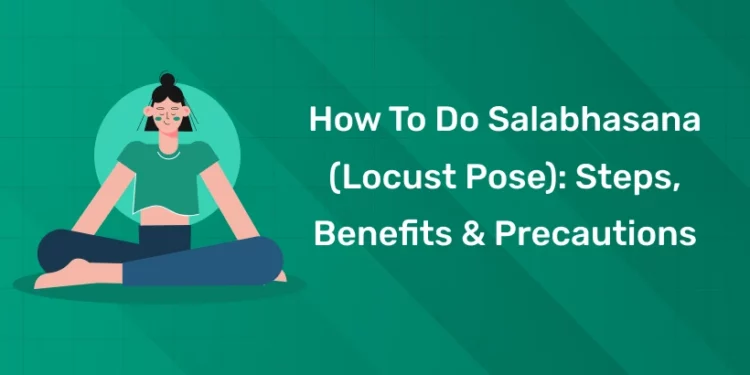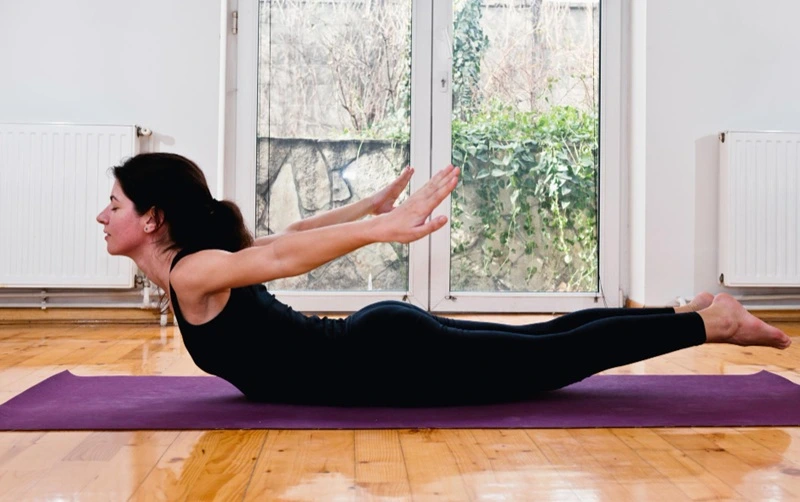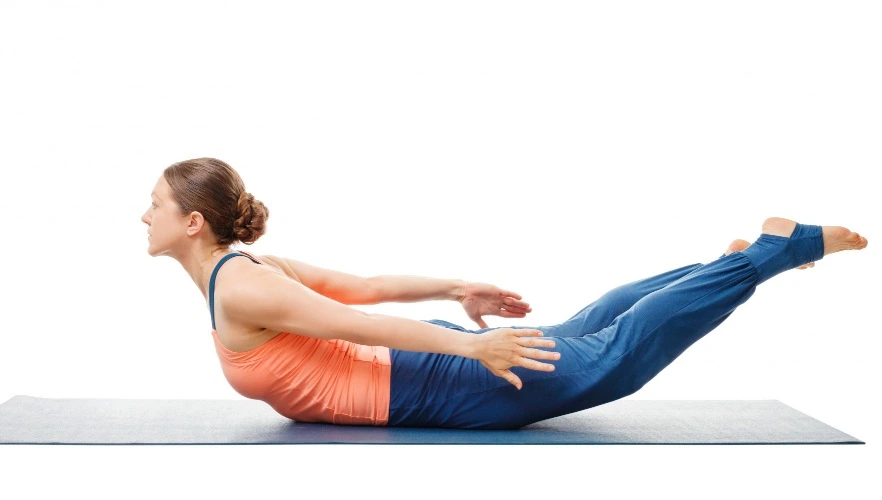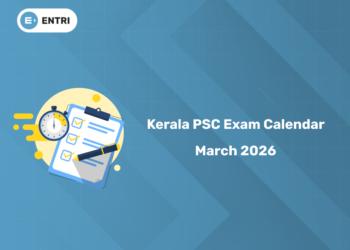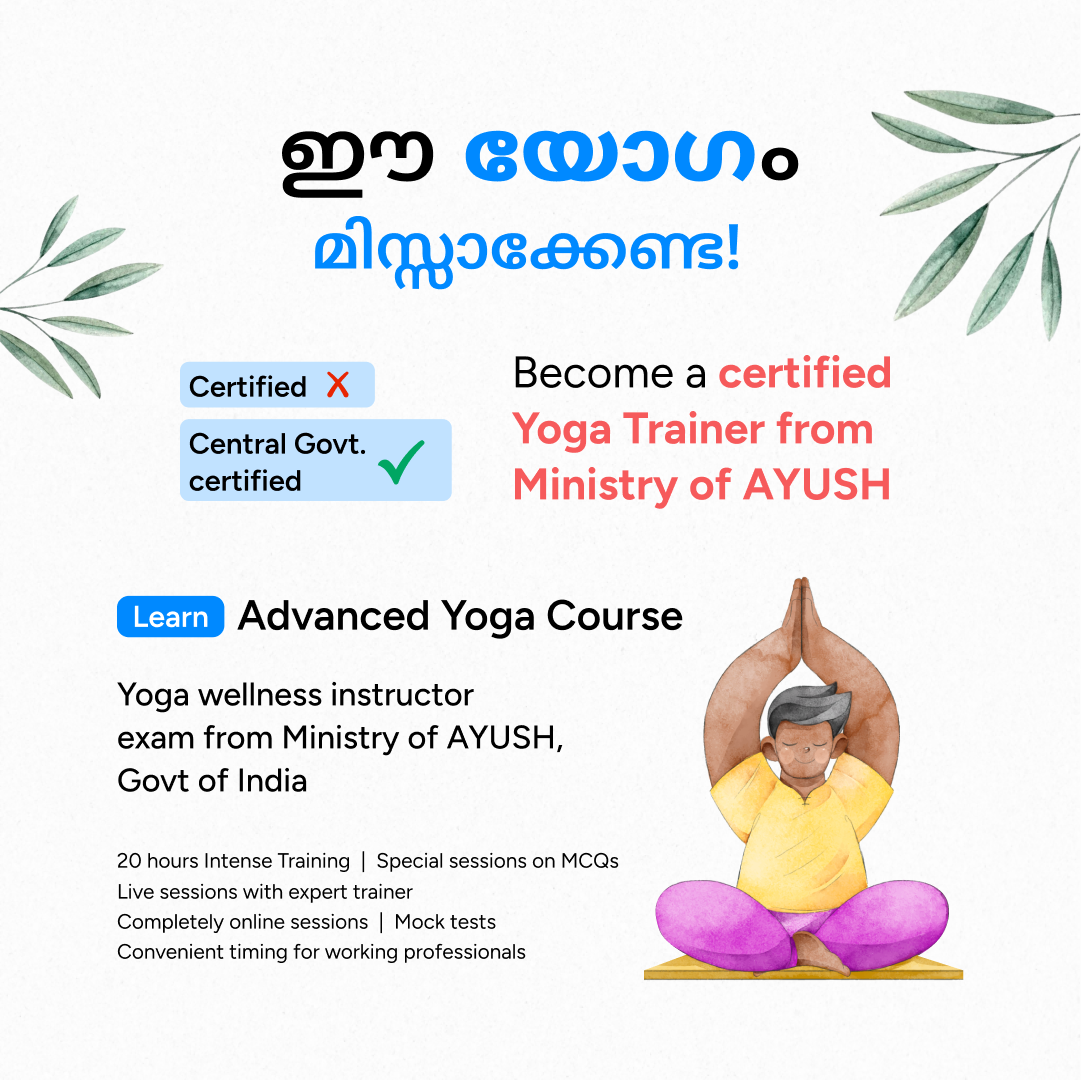Table of Contents
Salabhasana (शालभासन), Locust Pose, is a foundational prone backbend that trains strength, stamina, and healthy spinal mechanics without the intimidation factor of deep heart-openers. Don’t let its simplicity fool you: when taught well, Salabhasana builds the posterior chain (back body), refines core support, and prepares your body for stronger backbends like Dhanurasana (Bow), Urdhva Mukha Svanasana (Upward-Facing Dog), and even Urdhva Dhanurasana (Wheel).
This comprehensive guide gives you teacher-level clarity: step-by-step technique, alignment cues, anatomy-aware benefits, variations and props, contraindications, sequencing ideas, common mistakes, breathwork, and a ready-to-use class plan. You’ll also see how a structured programme like the Entri Yoga TTC (Teacher Training Course) helps you transform safe technique into great teaching.
Get Confident! Join Our Yoga Teacher Training Course!
What Is Salabhasana (Locust Pose)?
- Sanskrit: Śalabha = locust/grasshopper; āsana = posture.
- Shape: A prone (belly-down) backbend where the chest, arms, and/or legs lift away from the floor through active muscle engagement rather than passive pushing.
- Primary actions: Spinal extension via back muscles, scapular stability, glute–hamstring synergy, with abdominal tone to distribute the backbend evenly.
- Why it matters: It teaches strength before depth, a crucial principle for pain-free backbending and long-term practice.
Evidence-Informed Benefits
1: Which of these is the primary goal of yoga practice?
- Strengthens the posterior chain
Activates spinal extensors (erector spinae), gluteus maximus/medius, hamstrings, and the mid-back (rhomboids, lower traps), supporting posture and resilience. - Counters desk posture
Encourages thoracic extension and scapular control, which can reduce the “rounded shoulders/forward head” pattern common with screen time. - Builds core synergy
Though it’s a backbend, effective Salabhasana co-recruits abdominals to stabilise the lumbar spine, a vital habit for healthy movement. - Improves breath awareness
Front-body openness and rib mobility can support the feeling of fuller breathing (paired with nasal, diaphragmatic breath). - Teaches endurance & focus
Because it’s an isometric hold, Salabhasana builds mindful stamina, improving body awareness and mental steadiness.
Teacher note: Use language like “may support” and “often helps” rather than promises. Invite students to notice their experience.
Become a Certified Yoga Instructor
Yoga Teacher Training Course by Entri App: Master authentic yoga techniques, earn certification, and build a successful career as a professional yoga instructor.
Join Now!Contraindications & When to Modify
Avoid, postpone, or modify if you have:
- Acute low-back pain, sciatica flare, recent spinal surgery, or severe spondylolisthesis.
- Pregnancy (after the first trimester), prone work is generally avoided.
- Recent abdominal surgery, hernia, peptic ulcers, seek medical guidance.
- Uncontrolled hypertension, glaucoma, avoid intense holds or breath retention.
- Shoulder/neck injuries, modify arm positions and keep the neck neutral.
Golden rule: No sharp, radiating, or pinching pain. If it appears, lower, regress, or exit.
Step-by-Step: Foundational Salabhasana (Locust Pose)
Set-up (Prone):
- Lie on your belly. Place a folded blanket under your pelvis if you’re bony-hipped or feel pubic bone pressure.
- Legs hip-width apart (or together if that feels more stable). Point toes back; press the tops of the feet lightly.
- Forehead rests on the mat. Arms along your sides, palms facing down (or in), shoulders relaxed.
Execution:
- Inhale: Lengthen the crown forward and tailbone back, gently draw lower belly in and up to support the lumbar spine.
- Exhale: With the neck long, lift chest and arms a few centimetres. Reach fingertips toward heels; slide shoulder blades down and in (away from ears).
- Next inhale: Lift one or both legs by initiating from the upper hamstrings and glutes, not from the lower back. Keep length through both legs; big toes gently in line with the heels.
- Hold 3–5 slow breaths. Emphasise length over height. Keep the jaw soft and your gaze down/forward (neutral neck).
- Exhale to lower slowly. Turn one cheek to the mat, arms relaxed. Take two recovery breaths; repeat 2–3 rounds.
Quick teaching cue:
“Belly in, tail long. Inhale lengthen; exhale lift chest and arms. Next inhale, lift legs from the hips, keep the neck long, shoulders away from ears. Breathe; release smoothly.”
Alignment Checkpoints
- Neck: Back of neck long; no crunching. Gaze slightly forward and down.
- Shoulders/Scapulae: Shoulder blades glide downward and inward; collarbones broad; no “hiking” toward ears.
- Ribcage: Lower ribs heavy toward the mat; avoid thrusting them forward aggressively.
- Lumbar feel: Even, spacious extension, not a sharp jam. If pinchy, lower and re-organise (see fixes below).
- Legs: Lift from upper hamstrings & glutes, not by clamping the low back. Legs straight but not locked.
- Core: Gentle lower-belly tone to support the spine.
- Breath: Smooth, steady, never held.
Become a Certified Yoga Instructor
Yoga Teacher Training Course by Entri App: Master authentic yoga techniques, earn certification, and build a successful career as a professional yoga instructor.
Join Now!Variations & Props
- Half Locust: One Leg at a Time
Lift chest + one leg; alternate sides. Easiest on the lower back and great for learning hip extension mechanics. - Arms-Back Locust (Classical)
Arms alongside body, palms down or facing in. Balanced mid-back engagement with minimal shoulder strain. - Cactus Arms Locust
Elbows at 90°, forearms parallel to the floor. Trains scapular stability and posterior shoulder strength. If neck/shoulder sensitive, keep the chest low. - Interlaced Fingers Behind
Clasp hands behind sacrum; straighten arms and reach back. Increases shoulder opening; watch for rib flare. - Strap-Bound Locust
Hold a strap between hands behind you; pull the strap to encourage scapular retraction without jamming the shoulders. - Block Between Thighs
Squeeze a foam block high between thighs to cue inner-leg engagement and neutral femurs; reduces toe-out and lumbar sway. - Towel/Blanket Under Lower Ribs or Pelvis
Helpful if you feel rib tenderness or pubic bone pressure. Allows more comfort while you learn patterning. - Forehead on Block
Keeps the neck neutral and discourages over-extension if you tend to crank the chin up.
Common Mistakes & Smart Fixes
| Mistake | What You See/Feel | Fix (Cue/Prop) |
| Neck crunch | Chin jutting, jaw clenching | Gaze down/forward; lengthen through the crown; forehead on a low block if needed. |
| Shoulders hugging ears | Upper traps overworking | “Slide shoulder blades into back pockets.” Use strap-bound or arms-back variation. |
| Low-back pinch | Sharp jam at L4/L5 | Reduce height; emphasise belly tone; lift one leg at a time; place hands under hip points for feedback. |
| Legs splay outward | Toes turn out, glutes gripping | Block between thighs; cue inner-leg line and long tailbone. |
| Holding breath | Red face, tension | Count slow inhales/exhales; lower slightly to regain steady breath. |
| Over-using arms | Pushing down to lift | Arms hover; let the back body do the work. |
Breathwork & Bandha Notes
- Inhale: Imagine breath expanding across the ribs; the front body lengthens.
- Exhale: Gentle uddiyana tone (subtle lower-belly support), collarbones wide, legs stay long.
- No retention: Keep a smooth rhythm; brief holds only if well-tolerated and approved by your teacher/health professional.
Where Salabhasana Fits in a Sequence
Warm-ups (5–8 min):
- Cat–Cow (mobilise the spine)
- Thread the Needle/Puppy Pose (shoulder and thoracic prep)
- Sphinx (gentle thoracic extension)
- Prone glute/hamstring activation (bend knee, press thigh to mat; alternate)
Build (8–12 min):
- Half Locust (right/left; 2 rounds)
- Full Locust (arms back) (2 rounds, 3–5 breaths)
- Cactus-Arm Locust (posterior shoulder focus)
- Optional: Cobra (Bhujangasana) to integrate spinal extension with arm support
Complementary work:
- Bridge Pose (Setu Bandhasana) for hip extension and front-body opening without prone pressure
- Prone hamstring curls with strap (strength/coordination)
Counterposes (non-negotiable):
- Child’s Pose (Balasana): 5–8 breaths
- Supine knees-to-chest (Apanasana)
- Gentle supine twist (to neutralise)
20-Minute Home Practice Featuring Locust
- Centering (1 min): Belly down, forehead on hands; diaphragmatic breaths.
- Cat–Cow (2 min) → Puppy Pose (1 min)
- Sphinx (2 × 5 breaths): rest between rounds
- Half Locust (2 rounds each leg, 3–4 breaths)
- Full Locust, arms back (2 rounds, 3–5 breaths)
- Cactus-Arm Locust (1–2 rounds)
- Cobra (Low) (1 round, 3–4 breaths), optional
- Child’s Pose (1–2 min)
- Supine twist + Apanasana (2–3 min)
- Seated breath (1 min): slow exhale to ground
Teaching Different Bodies (Inclusivity Lens)
- Beginners/Desk Workers: Start with Sphinx → Half Locust → Low Full Locust. Keep neck neutral, focus on endurance.
- Hypermobile Students: Limit range; co-contract glutes and abdominals; avoid end-range “hanging.”
- Athletes/Runners: Cue glute–hamstring initiation to protect the lumbar spine; add Bridge Pose after.
- Prenatal: Avoid prone lying after 1st trimester; choose supported heart-openers (bolster under thoracic spine) and Bridge.
- Postnatal (after clearance): Rebuild with Sphinx and Half Locust; watch abdominal pressure; progress gradually.
- Neck/SI Sensitive: Keep gaze down, reduce height, narrow stance to comfort, and add more counterposes.
For Aspiring Yoga Teachers: Cueing, Observation, and Ethics
- Cue intent, not just shape: “Lengthen before you lift,” “Neck stays long,” “Lift from the hips, not the low back.”
- Observe patterns: Are students lifting with back muscles or pushing with arms? Are shoulders creeping up? Are legs splaying?
- Offer choices: Sphinx, Half Locust, arms-back Locust, cactus arms, strap-bound. Options make classes safer and more inclusive.
- Consent-based assists: Ask before touching; use minimal, educational touch (e.g., a tactile cue to lengthen through the crown).
- Progress gradually: Build from basics; let strength and patterning lead depth, not ego or aesthetics.
- Language of safety: “Pain-free range,” “Soften if breath gets choppy,” “Back off if you feel compression.”
How a Yoga TTC Levels Up Your Salabhasana
Great teachers turn safe mechanics into repeatable results. The Entri Yoga TTC course helps you:
- Decode anatomy of backbends: spinal curves, scapular mechanics, hip extension, and core synergy.
- Master progressions from Sphinx → Half Locust → Full Locust → Cobra/Up-Dog safely, with props and variations for diverse bodies.
- Design sequences (warm-ups, peaks, counterposes) that respect physiology and nervous-system states.
- Refine cueing & demos for clarity in mixed-level classes (English/Hinglish/Tamil classrooms as needed).
- Build assessment skills, observe, regress, or progress individuals responsibly, online and in person.
- Gain mentoring & feedback so you can teach with confidence, not just copy shapes.
If you’re serious about teaching or deepening your practice, a structured TTC turns information into embodied skill.
Key Takeaways
- Salabhasana builds strength before depth, posterior chain, scapular stability, and core synergy for safer backbends.
- Length precedes lift: keep neck long, collarbones broad, and ribs integrated to avoid lumbar compression.
- Start small: Sphinx and Half Locust teach patterning; increase height only when breath stays smooth and the lower back feels spacious.
- Props are wisdom, not weakness: block between thighs, strap behind back, blanket under pelvis/ribs.
- Always counterpose: Child’s Pose, Apanasana, gentle twists, and mindful breath to neutralise.
- Teachers: cue options, get consent for assists, and progress gradually; clear observation beats aggressive adjustments.
- Deepen through study: a quality Yoga TTC (like Entri’s) converts safe technique into confident, inclusive teaching.
Get Confident! Join Our Yoga Teacher Training Course!
Final Word
When you treat Locust Pose as a lesson in precision and patience rather than a race to lift higher, it becomes a powerful teacher: awakening your back body, refining your breath, and steadying your attention. Practice with curiosity, choose the variation that serves your spine today, and let strength build naturally.
If you’re ready to share this wisdom with others, the Entri Yoga TTC course can turn your careful self-practice into professional excellence, one mindful lift at a time.
Become a Certified Yoga Instructor
Yoga Teacher Training Course by Entri App: Master authentic yoga techniques, earn certification, and build a successful career as a professional yoga instructor.
Join Now!Frequently Asked Questions
Is Salabhasana good for back pain?
It can support back strength when done gently and pain-free. Start with Sphinx or Half Locust. If pain persists or radiates, stop and seek professional guidance.
Where should I feel Locust Pose?
Across the mid-back, glutes, and hamstrings with a sense of length in the front body, not a pinch in the lower back or strain in the neck.
How long should I hold?
Begin with 3–5 slow breaths, 2–3 rounds. Build endurance over weeks rather than forcing long holds on day one.
What if my neck hurts?
Keep gaze down/forward; place your forehead on a block initially; minimise height and avoid cranking the chin up.
What’s the difference between Locust and Cobra?
Locust is a muscle-driven lift (no hand push), focusing on the back body. Cobra uses arm support and opens the chest more; they complement each other.
Can I do Salabhasana daily?
Yes, if it’s pain-free and balanced with counterposes. Vary intensity (Half Locust one day, full Locust the next).
Can Locust improve posture?
It often supports postural balance by strengthening the posterior chain and training scapular stability, especially for deskbound folks.


